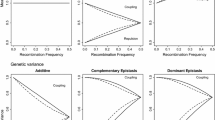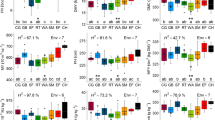Abstract
Theoretically, in a recurrent selection program, the use of doubled haploids (DH) can increase genetic advance per unit of time. To evaluate the efficiency expected from the use of DH for the improvement of grain yield in a maize (Zea mays L.) population, two recurrent selection programs for testcross performance were initiated using testcross progenies from DH lines and S1 families. In 4 years one selection cycle using DH and two selection cycles using S1 families were carried out with the same selection intensity for both methods. As expected, testcross genetic variance was twice as high among DH lines as among S1 families. The predicted genetic gain was 8.2% for the DH selection cycle, and 10.6% for the two S1 selection cycles, giving a per year advantage of 29% for the S1 family method over the DH method with a cycle of 4 years. With a 3-year cycle for the DH method, both methods were expected to be equivalent. Using a tester related to the one used for selection, the genetic gains obtained were equivalent for both methods: 6.6% for the DH cycle and 7.0% for the two S1 cycles. With a 3-year cycle for the DH method, the advantage would have been in favor of DH method. Furthermore, the DH method has the advantage of simultaneously producing lines that are directly usable as parents of a hybrid. Thus, if the genetic advance per unit of time is evaluated at the level of developed varieties even with the same or with a lower genetic advance in population improvement, the DH method appears to be the most efficient.


Similar content being viewed by others
References
Bianchi A, Marchesi G (1960) The surface of the leaf in normal and glossy maize seedlings. Z Vererbungsl 91:214–219
Bordes J, Dumas de Vaulx R, Lapierre A, Pollacsek M (1997) Haplodiploidization of maize (Zea mays L.) through induced gynogenesis assisted by glossy markers and its use in breeding. Agronomie 17:291–297
Bouchez A, Gallais A (2000) Efficiency of the use of doubled-haploids in recurrent selection for combining ability. Crop Sci 40:23–29
Chalyk ST (1994) Properties of maternal haploid maize plants and potential application to maize breeding. Euphytica 79:13–18
Nanda DK, Chase SS (1966) An embryo marker for detecting monoploids of maize (Zea mays L). Crop Sci 6:213–215
Coe E H (1959) A line of maize with high haploid frequency. Amer Nat 93:381–382
Crow JF, Kimura M (1970) An introduction to population genetics theory. Harper & Row Publishers, New York, 591p
Deimling S, Röber F, Geiger HH (1997) Methodik und Genetik der in-vivo-Haploideninduktion bei Mais. Vortr Pflanzenzüchtung 38:203–204
Falconer D S (1981) Introduction to quantitative genetics. Longman Group Ltd, Harlow
Gallais A (1988) A method of line development using doubled haploids: the single doubled haploid descent recurrent selection. Theor Appl Genet 75:330–332
Gallais A (1989) Optimization of recurrent selection on the phenotypic value of doubled haploid lines. Theor Appl Genet 77:501–504
Gallais A (1990a) Quantitative genetics of doubled haploid populations and application to the theory of line development. Genetics 124:199–206
Gallais A (1990b) Application of the concepts of the test value and of varietal value to the study of genetic advance in recurrent selection. Euphytica 48:197–209
Gallais A (1991) A general approach for the study of a population of test-cross progenies and consequences for the recurrent selection. Theor Appl Genet 81:493–503
Gallais A (1993) Efficiency of recurrent selection methods to improve the line value of a population. Plant Breed 111:31–41
Griffing B (1975) Efficiency changes due to use of doubled-haploids in recurrent selection methods. Theor Appl Genet 46:367–386
Hallauer AR, Miranda JB (1981) Quantitative genetics in maize breeding. Iowa State University Press, Ames
Hayes HK, Brewbaker HE (1928) Glossy seedlings in maize. Am Nat 62: 228–235
Kato A (2002) Chromosome doubling of haploid maize seedlings using nitrous oxide gas at the flower primordial stage. Plant Breed 121(5):370
Knapp SJ, Stroup WW, Ross WM (1985) Exact confidence intervals for heritability on a progeny mean basis. Crop Sci. 25:192–194
Lashermes P, Beckert M (1988) A genetic control of maternal haploidy in maize (Zea mays L.) and selection of haploid inducing lines. Theor Appl Genet 76:405–410
SAS Institute (2000) SAS/STAT user’s guide, Version 8. SAS Institute, Cary, NC
Sprague GF, Federer WT (1951) A comparison of variance components in corn yield trials: II Error, year × variety, location × variety, and variety components. Agron J 43:535–541
Strahwald JF, Geiger HH (1988) Theoretical studies on the usefulness of doubled-haploids for improving to efficiency of recurrent selection in spring barley. Proc 5th Meeting of the EUCARPIA Section “Biometrics in Plant Breeding”, 1–12
Acknowledgements
The authors are very grateful to the reviewers for their helpful suggestions. We are grateful to Annie Lapierre, Daniel Saint André and Bernard Coudert for the experimental work and the production of DH lines and to Felicity Vear for revision of the English. This work was supported by INRA and the Promaïs association members involved in this research: Caussade Semences, Euralis Génétique, Maïsadour Semences, Limagrain Genetics, R2N-RAGT Semences, Verneuil Recherche.
Author information
Authors and Affiliations
Corresponding author
Additional information
Communicated by R. Bernardo
Appendices
Appendix 1: derivation of the coefficient of inbreeding of the C1DH population
Among the 52 intercrossed DH lines used to develop the C1DH population, 28 derived from independent S1 with one DH line per S1, 18 derived from nine independent S1 with two DH lines per S1 and 6 derived from two independent S1 with three DH lines per S1.
The coefficient of inbreeding is defined as the probability of drawing at a locus in a zygote two genes identical by descent, i.e., deriving from the same ancestor gene. Assuming random mating, identity by descent in one zygote can result either from selfing with a probability of 1/52, or by crossing between sister lines, i.e., from the same S1. In the case of crossing between two sister lines, the expected inbreeding coefficient of progeny is1/2. One S1 with two sister lines generates two crosses between sister lines (including reciprocal); one S1 with three sister lines generates six crosses between sister lines. The total inbreeding coefficient will thus be:
Appendix 2: genetic advance in varietal development
Total genetic advance with varietal development (ΔG TV) is derived by adding genetic advance due to varietal development from one selection cycle of population improvement (ΔG V) and the cumulated genetic advance due to population improvement (ΔG P). Assuming linear response over the first cycles of selection, the expression of total genetic advance after n cycles of recurrent selection followed varietal development is
where ΔG P1 is the genetic advance in one cycle of population improvement. Such a genetic advance needs a time t=n c P+c V, where c P is the cycle length in population improvement (3 or 4 years for the DH method) and c V is the duration of varietal development. Therefore, genetic advance per unit of time can be derived.
To consider varietal development with the S1 method, several schemes are possible. As this is not the place to discuss all the schemes that are possible, we simplified by considering SSD from the best S1 and assumed that the same potential can be achieved as with DH. Using off-season nurseries, S5 or even S7 lines can be derived in 2 years with 1 year more for the evaluation of testcross progenies (which can begin at the S4 level). This gives a minimum duration of 5 years after the population resulting from intercrossing. The same formula as previously can then be used with appropriate parameters. Obviously, it is not justified to study more than 3–4 cycles without considering the possible decrease in genetic variance. It should be noted that 5 years is the minimum time for the derivation of lines without the use of DH; such a value favors S1 method.
Figure 1 shows the comparison of genetic advance per year for both methods with the following conditions:
-
the potential of varietal development for DH selection was computed by selecting the best 3% lines;
-
genetic variance among DH lines was taken to be equal to 44 which is the value estimated at the first DH selection cycle and which is quite consistent with variance among S1 estimated at the end of the experiment;
-
heritability at the level DH lines was taken to be equal to 0.80: it was estimated to be equal to 0.83 in the first selection cycle. Genetic advance due to varietal development ΔG V from any selection cycle was then computed as i h 2 σG=11.9 q ha−1; it should be noted that, with the assumption of the same potential for both methods in varietal development, such a quantity does not affect the difference between the two methods;
-
for the genetic advance due to population improvement, expected and realized values were taken into consideration.
Rights and permissions
About this article
Cite this article
Bordes, J., Charmet, G., de Vaulx, R.D. et al. Doubled haploid versus S1 family recurrent selection for testcross performance in a maize population. Theor Appl Genet 112, 1063–1072 (2006). https://doi.org/10.1007/s00122-006-0208-3
Received:
Accepted:
Published:
Issue Date:
DOI: https://doi.org/10.1007/s00122-006-0208-3




